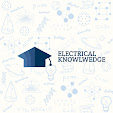NUCLEAR POWER PLANT
NUCLEAR POWER STATION
Nuclear Power Station
A generating station in which nuclear energy
is converted into electrical energy is known as a nuclear power station.
In a nuclear power station, heavy elements such
as Uranium (U235) or Thorium (Th232) are subjected to nuclear fission in a
special apparatus known as a reactor. The heat energy thus released is utilized
in raising steam at high temperatures and pressure. The steam runs the steam
turbine which converts steam energy into mechanical energy. The turbine drives
the alternator which converts mechanical energy into electrical energy.
The most important feature of a nuclear power
station is that a huge amount of electrical energy can be produced from a
relatively small amount of nuclear fuel as compared to other conventional types
of power stations. It has been found that complete fission of 1 kg of Uranium
(U235) can produce as much energy as can be produced by the burning of 4,500
tons of high-grade coal. Although the recovery of principal nuclear fuels
(i.e., Uranium and Thorium) is difficult and expensive, yet the total energy
content of the estimated world reserves of these fuels are considerably higher
than those of conventional fuels, viz., coal, oil, and gas. At present, the energy
crisis is gripping us and, therefore, nuclear energy can be successfully
employed for producing low-cost electrical energy on a large scale to meet the
growing commercial and industrial demands.
Schematic Arrangement of Nuclear Power Station:-
The schematic
arrangement of a nuclear power station. The whole arrangement can be divided into the following main stages:
(i)
Nuclear
reactor
(ii)
Heat
exchanger
(iii)
Steam turbine
(iv)
Alternator

Nuclear reactor.
It is an
apparatus in which nuclear fuel (U235) is subjected to nuclear fission. It
controls the chain reaction that starts once the fission is done. If the chain
reaction is not controlled, the result will be an explosion due to the fast
increase in the energy released.
A nuclear reactor is a cylindrical
stout pressure vessel and houses fuel rods of Uranium, moderator, and control
rods. The fuel rods constitute the fission material and release a huge amount of
energy when bombarded with slow-moving neutrons. The moderator consists of
graphite rods that enclose the fuel rods. The moderator slows down the
neutrons before they bombard the fuel rods. The control rods are of cadmium and
are inserted into the reactor. Cadmium is a strong neutron absorber and thus
regulates the supply of neutrons for fission. When the control rods are pushed
in deep enough, they absorb most of the fission neutrons, and hence few are
available for chain reaction which, therefore, stops. However, as they are
being withdrawn, more and more of these fission neutrons cause fission, and
hence the intensity of chain reaction (or heat produced) is increased.
Therefore, by pulling out the control rods, the power of the nuclear reactor is
increased, whereas by pushing them in, it is reduced. In actual practice, the
lowering or raising of control rods is accomplished automatically according to
the requirement of the load. The heat produced in the reactor is removed by the
coolant, generally a sodium metal. The coolant carries the heat to the heat
exchanger.
Heat exchanger.
The coolant gives up heat to the
heat exchanger which is utilized in raising the steam. After giving up heat,
the coolant is again fed to the reactor
Steam turbine.
The steam produced in the heat exchanger is
led to the steam turbine through a valve. After doing useful work in the
turbine, the steam is exhausted to a condenser. The condenser condenses the steam
which is fed to the heat exchanger through a feedwater pump.
Alternator.
The steam turbine
drives the alternator which converts mechanical energy into electrical energy.
The output from the alternator is delivered to the bus bars through the transformer,
circuit breakers, and isolators


No comments:
If you have any doubts, please let me know